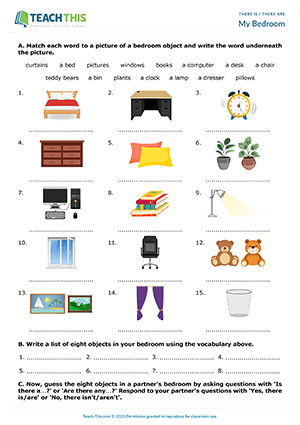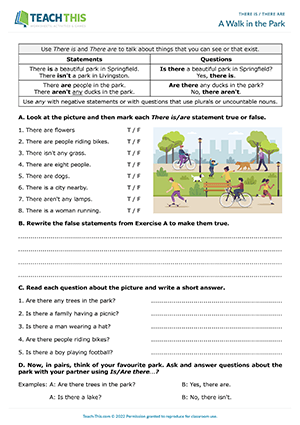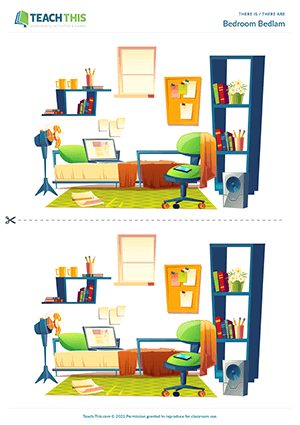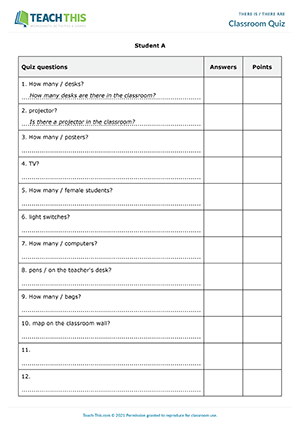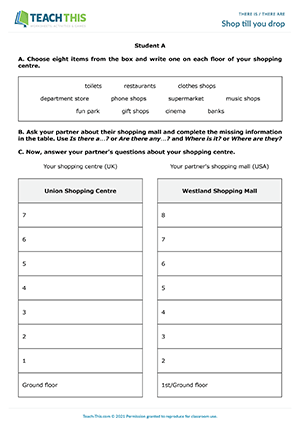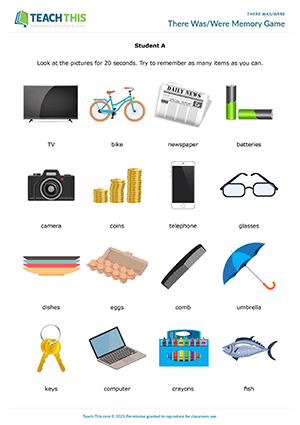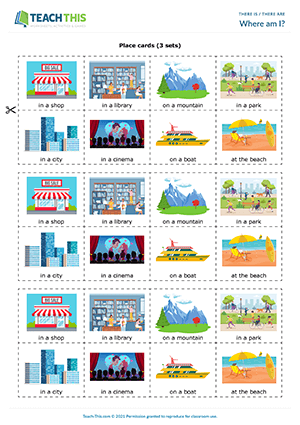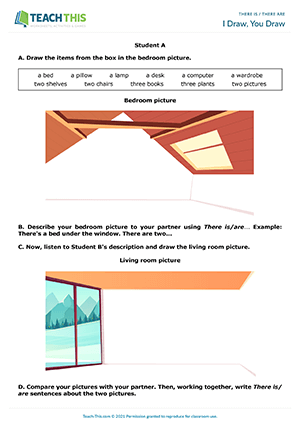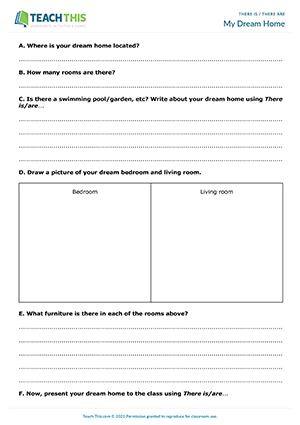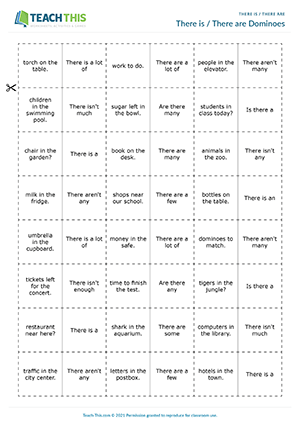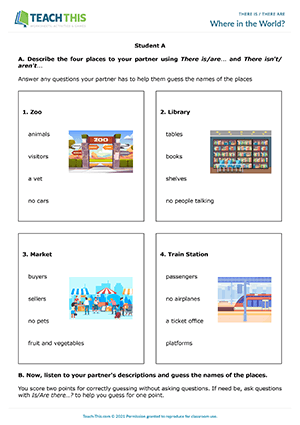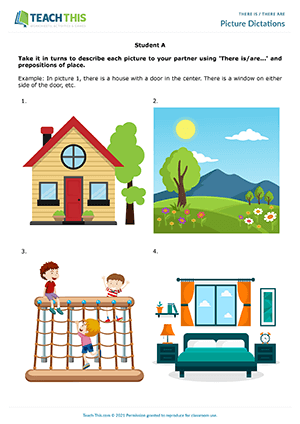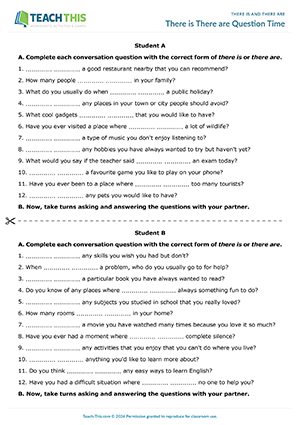In this engaging Is There and Are There activity, students match words with pictures of bedroom objects and review the vocabulary in a guessing game by asking questions with Is there a...? and Are there any...? First, students match each word to a picture of an object that is usually found in a bedroom and write the word underneath the picture. Students then write a list of eight objects in their bedroom using the vocabulary from the worksheet. Next, in pairs, students take turns guessing the eight objects in their partner's bedroom by asking questions with Is there a...? and Are there any...? Their partner responds with Yes, there is/are or No, there isn't/aren't as appropriate. When the students have finished, they repeat the game with another partner.
This productive There is and There are worksheet helps students learn There is and There are structures, including affirmative and negative statements, information questions and short answers. First, students look at a park scene picture and mark There is/are statements true or false. Next, students rewrite the false statements to make them true. After that, students answer yes/no questions about the picture using short answers. Lastly, students think of their favourite park and ask and answer questions about it with a partner using Is/Are there...?
In this free There is and There are game, students make There is/are statements about a bedroom picture. This activity also covers prepositions of place and furniture vocabulary. In pairs, students take turns turning over three word cards. If the words on the three cards go together to form a true sentence about the bedroom picture, the student reads the sentence aloud, places the three-card sentence under their picture and scores a point. The student with the most points at the end of the game is the winner.
In this interesting There is and There are game, students ask quiz questions about what's in the classroom to a partner, who uses their memory to answer the questions. First, in two groups, students complete quiz questions about the classroom with Is/Are there a/any...? or How many ... are there? Students then write the answer to each question. Next, students pair up with someone from the other group. One student closes their eyes, and their partner asks them the quiz questions about the classroom. The student then answers all the questions without opening their eyes, scoring one point for each correct answer and one point for forming a correct response, e.g. 'There are eight desks.' When all the questions have been answered, the two students swap roles. The student with the most points at the end of the game wins.
In this useful Is there and Are there speaking activity, students ask and answer questions about shops and shopping facilities using Is there a...? and Are there any...? This activity also helps to teach students about differences between British and American English. To begin, students create a shopping centre or mall by choosing eight shops or shopping facilities from a box on their worksheet and writing one on each floor of a building plan. Next, in pairs, Student A finds out what's on each floor of their partner's shopping mall by asking questions with Is there a...? and Are there any...? When Student A has completed the plan, Student B asks questions about Student A's shopping centre. Afterwards, students compare worksheets to check their answers.
Here is an enjoyable There was and There were memory game to help students practice There was and were statements and Was/Were there...? questions and short answers. First, students have 20 seconds to remember as many pictures as they can from the worksheet in front of them. After 20 seconds, students turn the worksheet over and write down as many items as they can remember using There was and There were, e.g. 'There was a TV.' Next, students swap their face-down worksheet with a partner and look at the pictures on their partner's worksheet. Students then take turns asking Was there a...? and Were there any...? questions to confirm if their sentences are right or wrong. Their partner answers Yes, there was/were or No, there wasn't/weren't as appropriate. Students score one point for each correctly remembered item. The student with the most points wins the game.
In this fun Is There and Are there game, students ask questions in order to find out where they are. To begin, students complete eight Is/Are there...? questions on a card. The questions should help them decide where they are. A picture of a place is then stuck on each student's back. In pairs, each student looks at the picture on their partner's back. Students then take turns asking the questions on their card to their partner to find out where they are. Students listen to their partner's answers and mark them on the card. When the students have asked all the questions, they write where they think they are. Students then see if they were right or wrong by taking the picture off their back.
In this rewarding There is and There are activity, students use There is/are... to describe a picture of a room and draw a room picture by listening to another student's description. This activity also covers furniture vocabulary and prepositions of place. In two groups, students draw items from a box in an empty room picture on their worksheet. Next, students pair up with someone from the other group and take turns describing their room picture to their partner using There is/are and prepositions of place, e.g. 'There's a bed under the window.' Their partner listens and draws the picture on their worksheet. Afterwards, in their pairs, students write There is/are sentences about both pictures. Finally, review the sentences by having the students show their pictures and read out their sentences.
In this inventive There is and There are worksheet, students write about their dream home using There is/are... First, students use There is and There are to write about their dream home by answering the questions on the worksheet in sentence form and drawing pictures of their dream bedroom and living room. When the students have finished, they present their dream home to the class by reading their answers to the questions and showing their pictures.
Here is a free apartment-themed worksheet to help students practice There is and There are. First, students read a text about the type of apartment Tyler and Kayla are looking for. Students then go through information about four apartments they could be interested in. Next, students answer Is/Are there questions about the four apartments using short answers from a box. Students then correct mistakes in There is/are sentences about the apartments. After that, students write Is there or Are there questions for a set of answers. Lastly, students choose the apartment that they think is best for Tyler and Kayla and write a description of it using There is and There are. Afterwards, students read their descriptions to the class and discuss which would be the most suitable apartment for the two people.
In this productive There is and There are game, students play dominoes by making affirmative and negative There is/are(n't) statements and questions with Is/Are there. In groups, the first player tries to make an affirmative or negative There is/are(n't) statement or question with Is/Are there by placing one of their dominoes at either end of the domino on the table. The player then reads the statement or question to the group for confirmation. The other group members judge the player's statement or question, making sure the quantifier and countable or uncountable noun match. If the statement or question is wrong, the player must take back the domino. Play then passes to the next student, and so on. The first player to get rid of all their dominoes wins the game.
In this fun There is and There are game, students describe common places using There is/are and There isn't/aren't for a partner to guess. In pairs, students take turns using the prompts on the worksheet to describe places with There is/are and There isn't/aren't to their partner who listens and tries to guess the name of the place. Students score two points for correctly guessing without asking questions. If need be, they ask questions with Is/Are there...? to help them guess for one point. The student with the most points at the end of the game wins. Finally, pairs write their own description of a common place and then take turns reading their descriptions to the class who tries to guess the name of the place.
In this entertaining There is and There are drawing activity, students use There is/are and prepositions of place to dictate pictures to each other. In pairs, students take turns describing the pictures to their partner using There is/are and prepositions of place, e.g. 'In picture 1, there is a house with a door in the centre. There is a window on either side of the door, etc.' Their partner listens and draws the picture in the empty box on their worksheet. This continues until both students have described all four pictures. When the students have finished, they check their work by comparing pictures.
In this insightful There is and There are speaking activity, students practice forming, asking and answering conversation questions that contain various forms of there is and there are. First, in two groups, students complete each conversation question with the correct form of there is or there are. Next, students pair up with someone from the other group and take turns asking and answering the conversation questions with their partner, responding with an answer that includes there is or there are in its correct form. Afterwards, students share what they found out about their partner with the class.
Latest Free
Resources
- Present Perfect Bingo
Present Perfect Yes No Questions (A2)
Date Added: 4th of March
- Count on Me!
Making Offers and Promises (A2)
Date Added: 11th of February
- It’s Carnival Time!
Cultural Celebrations (B1)
Date Added: 29th of January
- Identifying and Clarifying Problems
Dealing with Problems (B2)
Date Added: 1st of November
- The Bus Stop
Getting Around (B1)
Date Added: 1st of October
Latest Member
Resources
- What have you learned about me?
Present Perfect Yes No Questions (A2)
Date Added: 4th of March
- Have I guessed right?
Present Perfect Yes No Questions (A2)
Date Added: 4th of March
- Reading Rotation Challenge
Reading Exam Preparation (B1)
Date Added: 3rd of March
- Who has asked the right question?
Present Perfect Wh Questions (B1)
Date Added: 26th of February
- Perfectly Played!
Present Perfect Wh Questions (B1)
Date Added: 25th of February



